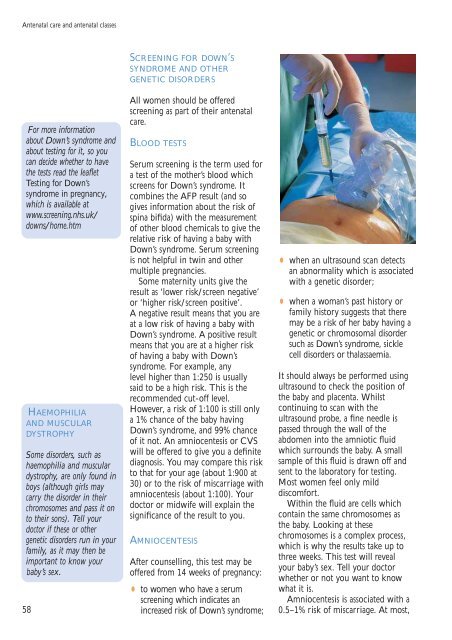here - Health Promotion Agency
here - Health Promotion Agency
here - Health Promotion Agency
You also want an ePaper? Increase the reach of your titles
YUMPU automatically turns print PDFs into web optimized ePapers that Google loves.
Antenatal care and antenatal classes<br />
For more information<br />
about Down’s syndrome and<br />
about testing for it, so you<br />
can decide whether to have<br />
the tests read the leaflet<br />
Testing for Down’s<br />
syndrome in pregnancy,<br />
which is available at<br />
www.screening.nhs.uk/<br />
downs/home.htm<br />
HAEMOPHILIA<br />
AND MUSCULAR<br />
DYSTROPHY<br />
Some disorders, such as<br />
haemophilia and muscular<br />
dystrophy, are only found in<br />
boys (although girls may<br />
carry the disorder in their<br />
chromosomes and pass it on<br />
to their sons). Tell your<br />
doctor if these or other<br />
genetic disorders run in your<br />
family, as it may then be<br />
important to know your<br />
baby’s sex.<br />
58<br />
SCREENING FOR DOWN’S<br />
SYNDROME AND OTHER<br />
GENETIC DISORDERS<br />
All women should be offered<br />
screening as part of their antenatal<br />
care.<br />
BLOOD TESTS<br />
Serum screening is the term used for<br />
a test of the mother’s blood which<br />
screens for Down’s syndrome. It<br />
combines the AFP result (and so<br />
gives information about the risk of<br />
spina bifida) with the measurement<br />
of other blood chemicals to give the<br />
relative risk of having a baby with<br />
Down’s syndrome. Serum screening<br />
is not helpful in twin and other<br />
multiple pregnancies.<br />
Some maternity units give the<br />
result as ‘lower risk/screen negative’<br />
or ‘higher risk/screen positive’.<br />
A negative result means that you are<br />
at a low risk of having a baby with<br />
Down’s syndrome. A positive result<br />
means that you are at a higher risk<br />
of having a baby with Down’s<br />
syndrome. For example, any<br />
level higher than 1:250 is usually<br />
said to be a high risk. This is the<br />
recommended cut-off level.<br />
However, a risk of 1:100 is still only<br />
a 1% chance of the baby having<br />
Down’s syndrome, and 99% chance<br />
of it not. An amniocentesis or CVS<br />
will be offered to give you a definite<br />
diagnosis. You may compare this risk<br />
to that for your age (about 1:900 at<br />
30) or to the risk of miscarriage with<br />
amniocentesis (about 1:100). Your<br />
doctor or midwife will explain the<br />
significance of the result to you.<br />
AMNIOCENTESIS<br />
After counselling, this test may be<br />
offered from 14 weeks of pregnancy:<br />
•<br />
to women who have a serum<br />
screening which indicates an<br />
increased risk of Down’s syndrome;<br />
• when an ultrasound scan detects<br />
an abnormality which is associated<br />
with a genetic disorder;<br />
•<br />
when a woman’s past history or<br />
family history suggests that t<strong>here</strong><br />
may be a risk of her baby having a<br />
genetic or chromosomal disorder<br />
such as Down’s syndrome, sickle<br />
cell disorders or thalassaemia.<br />
It should always be performed using<br />
ultrasound to check the position of<br />
the baby and placenta. Whilst<br />
continuing to scan with the<br />
ultrasound probe, a fine needle is<br />
passed through the wall of the<br />
abdomen into the amniotic fluid<br />
which surrounds the baby. A small<br />
sample of this fluid is drawn off and<br />
sent to the laboratory for testing.<br />
Most women feel only mild<br />
discomfort.<br />
Within the fluid are cells which<br />
contain the same chromosomes as<br />
the baby. Looking at these<br />
chromosomes is a complex process,<br />
which is why the results take up to<br />
three weeks. This test will reveal<br />
your baby’s sex. Tell your doctor<br />
whether or not you want to know<br />
what it is.<br />
Amniocentesis is associated with a<br />
0.5–1% risk of miscarriage. At most,

















